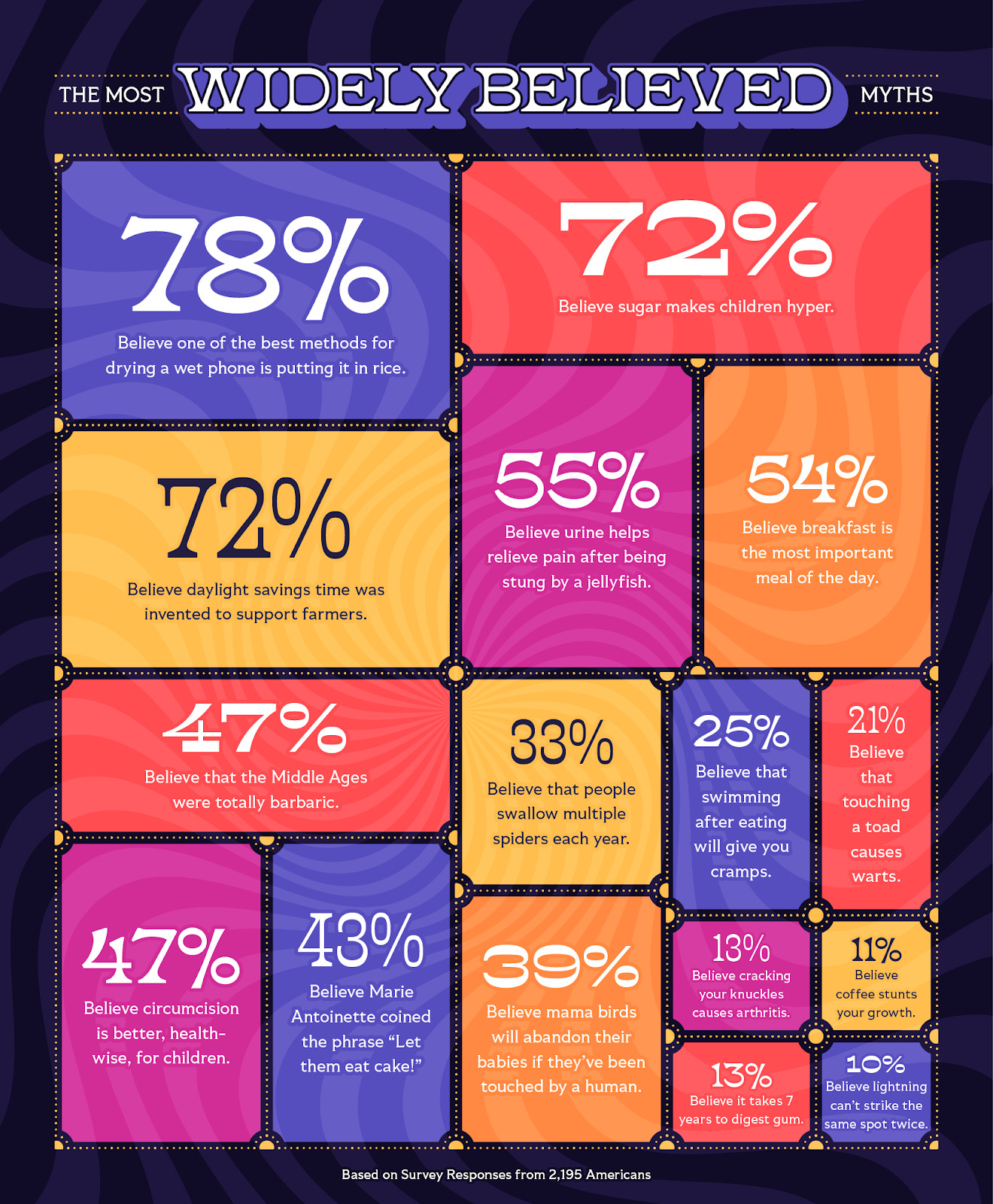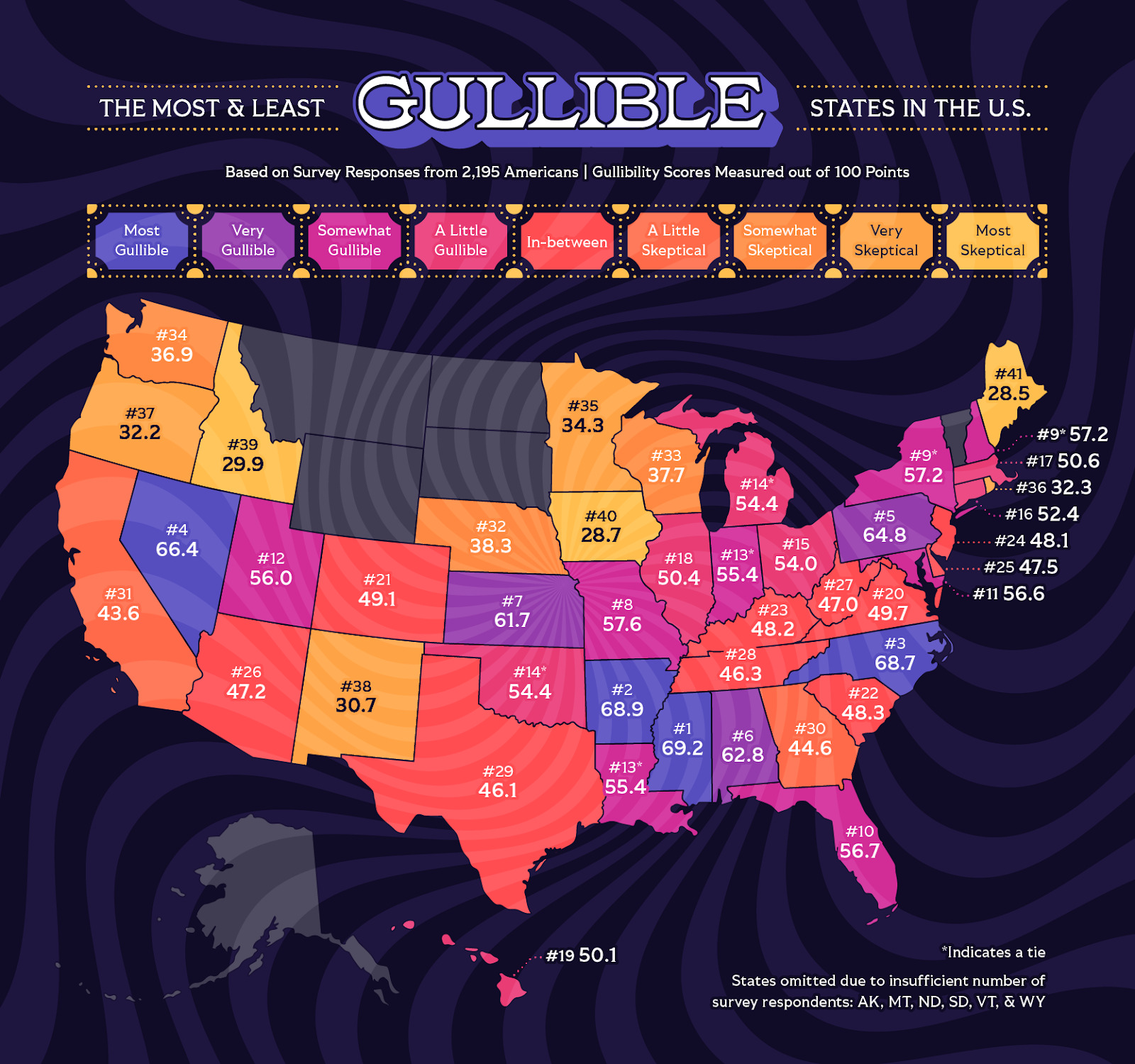
We’ve all heard them — those myths that stick with you like bubblegum on a hot sidewalk. “Wait 30 minutes after eating to swim,” they say. “Don’t crack your knuckles, or you’ll get arthritis,” warn the cautious. But how many of these long-standing beliefs actually hold water? Spoiler alert: not many.
At MRO Electric, we’re not just about keeping your operations running smoothly but also about setting the record straight. So, we took it upon ourselves to survey Americans to determine which states are most likely to fall for these myths: hook, line, and sinker.
Are you ready to find out if your state made the list? Or better yet, are you prepared to challenge some of your long-held beliefs? Buckle up, because we’re about to take you on a myth-busting journey across America.
Believe It Or Not! These Are the Most Widely Believed Myths

First, we wanted to know which myths have most Americans bamboozled. The #1 most believed myth is that rice is one of the best methods for drying a wet phone, with a staggering 78.2% believing rice is a tech lifesaver. While it’s true that rice can absorb moisture, it’s not the most efficient way to dry your phone. In fact, leaving your phone in rice can actually cause more harm by leaving residue in the device.
Next, the sugar-hyperactivity link is believed by 72.4%. Studies have shown no direct correlation between sugar and hyperactivity in children. The “sugar high” is more likely a result of the excitement around sweets or desserts, not the sugar itself.
As for the 72% who think daylight savings is for the farmers, it was actually introduced during World War I to save energy. The practice aimed to use daylight during the evenings better, thereby conserving fuel. Farmers were, ironically, some of its biggest opponents.
The jellyfish sting remedy is another slippery myth, with 55% thinking urine is the answer. Urine can actually aggravate the jellyfish’s stingers into releasing more venom. Fresh water is not advisable either; instead, salt water or vinegar is recommended to neutralize the sting.
While breakfast is important for kick-starting your metabolism, saying it’s the “most important meal” isn’t entirely accurate. The breakfast myth is endorsed by 53.6% of respondents, with more women than men believing it. Balanced daily meals and snacks are crucial for sustained energy and health.
Do we swallow multiple spiders each year? Yes, according to one in every three people. Rest assured, spiders are not interested in crawling into a human mouth. This urban legend has been widely discredited, yet it makes many people uneasy.
And then there’s the knuckle-cracking concern: about 13.4% of people think it leads to arthritis. Medical research has found no such link; the sound you hear is actually gas bubbles bursting in your joints.
The Most and Least Gullible U.S. States

Next, we wanted to know where these myths are most commonly believed, and which U.S. states are in turn, the most gullible.
Topping our list as the most gullible state is Mississippi, with a score of 69.2 out of 100. The Magnolia State seems to be a fertile ground for myths and misconceptions to flourish. 53% of residents firmly believe that a mama bird will abandon its baby bird if a human touches it. It’s a state rich in history and tradition, but some of those traditions may need a fact-check.
Just a hair behind is Arkansas, scoring 68.9 out of 100. Known for its natural beauty with places like the Ozark Mountains, it seems that folklore and myths have found a way to integrate themselves into the local culture. One out of four incorrectly believes it takes the body seven years to digest swallowed gum.
North Carolina rounds out the top three most gullible states, scoring 68.7. Home to both the Great Smoky Mountains and bustling cities like Charlotte, the state presents a unique blend of the modern and the traditional. Unfortunately, this blend seems to include a mix of widely-believed myths. North Carolinians will likely believe that touching a toad will give you warts.
On the other end of the spectrum, we find Maine as the least gullible state, boasting a low score of 28.5 out of 100. Mainers are not fooled by the allure that cracking your knuckles causes arthritis, among other myths. Perhaps the salty sea air clears the mind, or maybe the independent spirit of Mainers keeps them questioning the status quo.
Iowa comes in as the second least gullible state, scoring 28.7. Famous for its cornfields and as the first caucus in the U.S. presidential primaries, Iowa has a populace that’s grounded in facts more than fiction. Speaking of history, Iowans are not on board with the false assumption that the Middle Ages were totally barbaric.
Idaho is third on our least gullible list, scoring 29.9 out of 100. Beyond its famous potatoes, Idaho is cultivating a healthy dose of skepticism among its residents. Just 13% of residents believe they are actively swallowing several spiders in their sleep each year.
Closing Thoughts
One thing is clear: myths and misconceptions have a captivating hold on us, regardless of where we call home. But just like a faulty circuit, these myths can easily be debunked with the right information. At MRO Electric, we’re committed to providing top-notch electrical and power services and enlightening our customers with facts over fiction.
Knowledge is power, and we’re here to empower you to make well-informed decisions, both in your electrical needs and life. Get in touch today and let’s bust some myths together!
Methodology
To find out which myths are most widely believed around the U.S., we surveyed 2,195 Americans across the country true or false questions about commonly believed myths according to Buzzfeed.
From there, we wanted to know which states were the most and least gullible regarding these myths. We analyzed responses, then evenly weighted each question to give every state analyzed a score out of 100 (with a score of 0 being not believing myths, and not gullible; and 100 believing many myths, being completely gullible).
It’s worth noting that due to their lower populations, we did not receive enough responses from Alaska, Montana, North Dakota, South Dakota, Vermont, and Wyoming to include.
Updated on January 3, 2024 by Leanna Cota